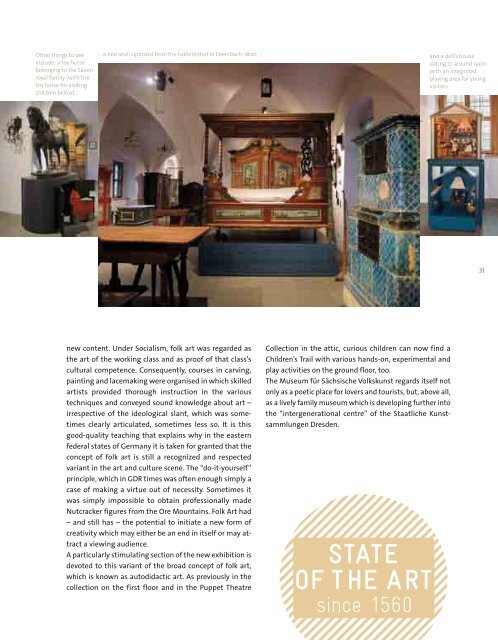Annual Report 2010 - Staatliche Kunstsammlungen Dresden
Annual Report 2010 - Staatliche Kunstsammlungen Dresden
Annual Report 2010 - Staatliche Kunstsammlungen Dresden
Create successful ePaper yourself
Turn your PDF publications into a flip-book with our unique Google optimized e-Paper software.
Other things to see<br />
include: a toy horse<br />
belonging to the saxon<br />
royal family (with the<br />
toy horse for visiting<br />
children below)…<br />
… a bed and cupboard from the Faktorenhof in Ebersbach, 1800, …<br />
new content. Under Socialism, folk art was regarded as<br />
the art of the working class and as proof of that class’s<br />
cultural competence. Consequently, courses in carving,<br />
painting and lacemaking were organised in which skilled<br />
artists provided thorough instruction in the various<br />
techniques and conveyed sound knowledge about art –<br />
irrespective of the ideological slant, which was sometimes<br />
clearly articulated, sometimes less so. It is this<br />
goodquality teaching that explains why in the eastern<br />
federal states of Germany it is taken for granted that the<br />
concept of folk art is still a recognized and respected<br />
variant in the art and culture scene. The “doityourself”<br />
principle, which in GDR times was often enough simply a<br />
case of making a virtue out of necessity. Sometimes it<br />
was simply impossible to obtain professionally made<br />
Nutcracker figures from the Ore Mountains. Folk Art had<br />
– and still has – the potential to initiate a new form of<br />
creativity which may either be an end in itself or may attract<br />
a viewing audience.<br />
A particularly stimulating section of the new exhibition is<br />
devoted to this variant of the broad concept of folk art,<br />
which is known as autodidactic art. As previously in the<br />
collection on the first floor and in the Puppet Theatre<br />
Collection in the attic, curious children can now find a<br />
Children’s Trail with various handson, experimental and<br />
play activities on the ground floor, too.<br />
The Museum für Sächsische Volkskunst regards itself not<br />
only as a poetic place for lovers and tourists, but, above all,<br />
as a lively family museum which is developing further into<br />
the “intergenerational centre” of the <strong>Staatliche</strong> <strong>Kunstsammlungen</strong><br />
<strong>Dresden</strong>.<br />
and a doll’s house<br />
dating to around 1900<br />
with an integrated<br />
playing area for young<br />
visitors<br />
31

















